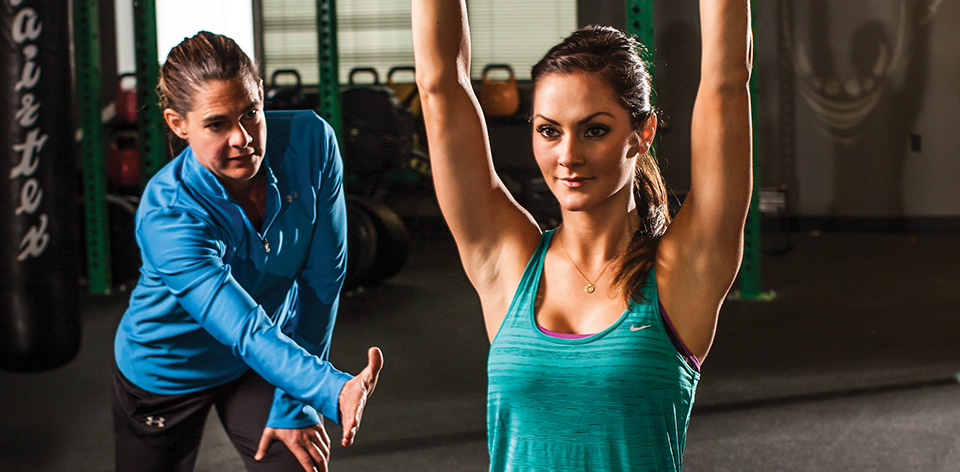Cross Training for Quicker Legs

If we were to analyze our body movement in regard to running, we would notice a forward motion in one direction. Running is mainly a lower body exercise, using the legs with a little help from the upper body for counter balance. It is often overlooked in training that, to have great force production in forward motion, we must first be able to guide that movement with great lateral stability in the frontal plane. In order to generate power through each and every step, and for the entire body to contribute to that power, we must have a good connection through the core.
Another thing that makes lower body power and running truly efficient is the ability to achieve triple flexion and extension of the ankle, knee, and hip with good stability (i.e. motor control) to drive that movement and those generated forces in the intended direction. The following exercises will help enhance your running mechanics and add to your ability to generate faster, stronger steps in the most streamline direction needed. (Great for supplementing your training if you are preparing to compete in the AFM Fittest on May 30!)

Lunge and Overhead Press with Steel Mace
Purpose: This movement combines a lower body movement in a narrow base with mechanics and strength needed in running. An additional benefit: using the steel mace with an asymmetrical, one-sided load challenges the stability laterally in the frontal plane. Controlling the offset weight will translate into better and more efficient forward movement.
Movement:
- Start by standing tall with the steel mace at the chest.
- Step out into the lunge with feet hip-width apart while maintaining an upright torso. Simultaneously press the weight directly overhead using full extension of the arms.
- Make sure to establish a stable base of support with the feet while in the lunge position, and then push off the heel of the front foot to return to the start position.
- Be sure not to let the offset weight pull you out of balance or create a lateral shift in the torso or upper body. The objective is to feel the lateral force but maintain control to resist it.

Leg Drive with Core Activation
Purpose: One of the key aspects of any locomotion movement—whether walking, running, skipping, or changing direction—is that it requires alternating control of each leg. This is why the ability to have a strong, single leg stance is important. By activating your core to control the pelvis, one leg can flex into leg drive position with power while the opposite leg extends with power. If there is not good timing and sequence when the core or torso activates to create stability, then it makes it difficult for the lower body to express the leg drive.
Movement:
- Start by standing tall and holding a band with arms extended and palms down. The band should be anchored at eye-level or above.
- The timing of each movement is important. First, pull down with the arms to engage the core.
- Then, as fast as you can control (which may not be “fast” at all for some), drive the knee to waist level using triple flexion of the ankle, knee, and hip.
- Pause to establish control and stability at the top and then return the leg back to the start position. Then, release the arms by returning them to start.
- This sequence of movements is important to trigger core activation more reflexively to establish forceful leg drive on each step.
- So, to start: Pull down, engage core, then drive the leg up. To return: Extend leg, release arms, and stand tall to finish.

Single Leg Squat on Box
Purpose: Lowering the body using its own weight is a great way to challenge strength, balance, and stability on a single leg. You can easily start with a partial squat and work your way into a full squat as you become stronger. Squatting on the box allows the free leg to remain more neutral to the body as it hangs to the side rather than having to hold it flexed out in front of the body. As the body learns this simple yet challenging movement, it is critical to follow good form and aim to improve form and technique on every repetition.
Movement:
- Start in a single leg stance on a 12-inch to 18-inch box or step standing tall and eyes forward. Opposite leg should be off to the side to clear the box on descent.
- Lower your body by flexing ankle, knee and hip on the leg that is planted on the box and sit back into a squat like your reaching for an imaginary chair behind you. Only go as far as you can while still maintaining balance and control.
- Once you reach your end range of controlled movement, push through the heel to engage your strong, backside muscles to extend the leg and return to standing tall.
- Avoid any caving inward of the knee. The ankle, knee, and hip of the squatting leg should always be vertically aligned all the way down and all the way back to standing.






